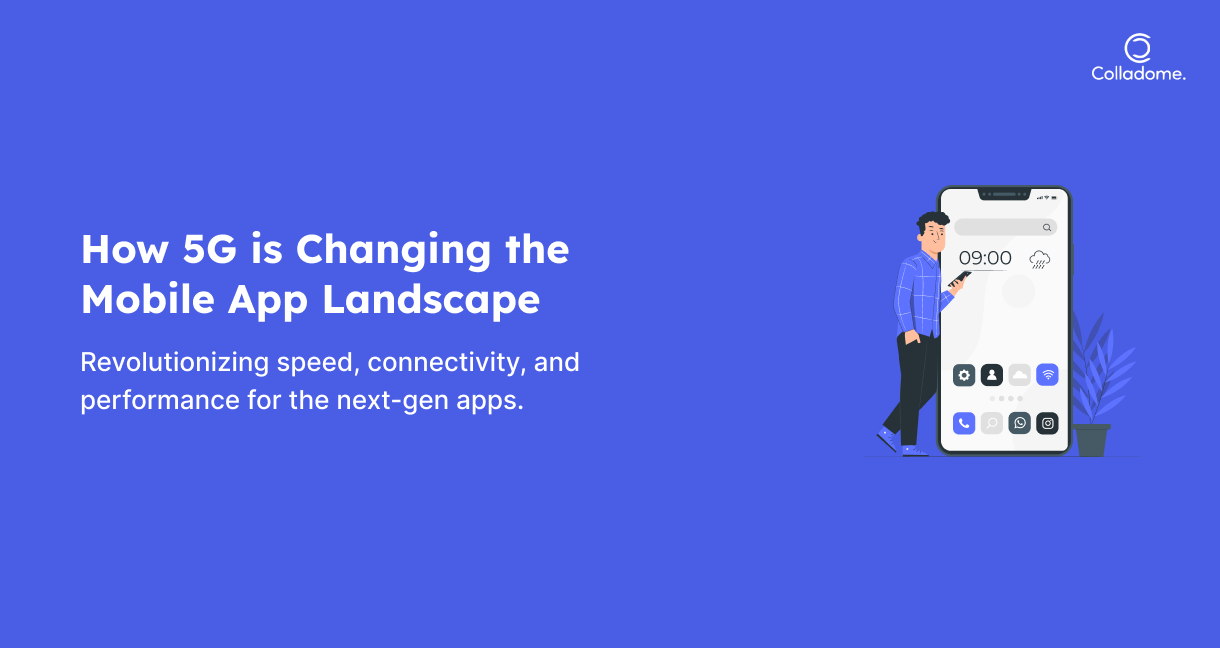The arrival of 5G is a big deal—seriously, it’s not just another tech buzzword. It’s set to completely change how we use mobile apps. Imagine downloading an entire HD movie in seconds or experiencing mobile gaming with zero lag. That’s the power of 5G.
So, what’s the deal? 5G offers download speeds up to 100 times faster than 4G, with lower latency (less delay) and the ability to connect millions of devices simultaneously. For app developers, this means apps can run faster, smoother, and handle more data in real-time. For example, 5G speeds can reach up to 10 Gbps in ideal conditions, while 4G maxes out at about 100 Mbps.
This is a game-changer for everything from real-time apps like video conferencing and live-streaming to augmented reality (AR) and virtual reality (VR) experiences. Gaming apps will thrive as 5G allows ultra-low latency for seamless gameplay, while IoT apps (Internet of Things) will flourish with the ability to manage massive networks of devices without a hitch.
What’s Next? By 2025, it’s predicted that 1.7 billion 5G connections will exist globally, creating a massive market for mobile app developers. As 5G adoption grows, expect apps to get faster, smarter, and more immersive, taking full advantage of this new tech wave.
So, get ready, because 5G is the future!
Why is 5G Such a Big Deal for Mobile Apps?

Here’s the scoop: mobile apps are getting hungrier. We’re not just talking about a simple game or an occasional movie stream. Apps today are data-driven monsters that demand high-speed connections, tons of bandwidth, and almost zero lag. Think streaming HD movies, multiplayer gaming, and real-time collaboration tools—all of these require fast, reliable networks to function at their best. Enter 5G.
-
Blazing Speeds:
With 5G, apps are about to go into overdrive. While 4G maxes out at around 100 Mbps, 5G can hit 10 Gbps, which is 100x faster than 4G. Imagine downloading an entire movie in seconds, instead of waiting forever. Whether it’s binge-watching on Netflix or downloading a game, speed is no longer an issue.
-
Ultra-Low Latency:
Latency, or the delay in sending data between devices, is a huge deal. For example, in remote surgery or live AR gaming, even a split-second delay could be catastrophic. 5G reduces latency to as low as 1 millisecond, enabling apps like remote surgery tools and real-time AR games to thrive. With no delay, experiences are smoother, faster, and far more interactive.
-
Massive Device Connectivity:
5G is designed to handle millions of devices simultaneously. This is a game-changer for IoT-driven apps like smart home systems, connected cars, and smart cities. Experts predict by 2025, there will be 1.7 billion 5G connections globally. That’s a massive infrastructure boost for the Internet of Things, creating a more connected, efficient world.
In short, 5G isn’t just a nice-to-have. It’s a must-have for powering the next generation of high-performance apps and smart technologies. It’s not just faster—it’s a whole new level of mobile experience.
Take a look at how 5G stacks up against its predecessor:

| Feature | 4G LTE | 5G |
| Download Speed | 100 Mbps | Up to 10 Gbps |
| Latency | 50 ms | ~1 ms |
| Connected Devices per Sq. Km | 10,000 | 1,000,000 |
How 5G is Revolutionizing Mobile App Development
1. Mobile Gaming: The Ultimate Playground

Mobile gaming apps are some of the biggest winners. Multiplayer games, cloud gaming, and AR experiences get a massive boost. Ever tried cloud gaming on 4G? The lag ruins the fun. With 5G, platforms like Microsoft’s xCloud and NVIDIA GeForce Now are changing the game.
Case Study: Pokémon GO
Remember the AR sensation Pokémon GO? Niantic, the developers, are now leveraging 5G to introduce ultra-immersive features like real-time multiplayer AR battles. Faster speeds mean more engaging gameplay with minimal lag.
Benefits of 5G for Mobile Gaming Apps

Let’s face it, mobile gaming has come a long way, but 5G is about to take it to the next level. If you’re a gamer, then get ready for a whole new experience. Here’s why 5G is a game-changer for mobile gaming apps:
-
Zero Lag – Say Goodbye to Latency:
In competitive gaming, lag is the enemy. One second of delay can cost you the game. With 5G, latency is slashed down to as low as 1 millisecond. Compare that to 4G’s latency of about 30-50 milliseconds, and you’ll see how this boost can make a huge difference. For real-time, fast-paced games like Fortnite or PUBG Mobile, 5G ensures that every move and action happens instantly, giving players a true edge in competitive play. No more rage-quitting because of lag!
-
Enhanced AR and VR Experiences:
Augmented reality (AR) and virtual reality (VR) are already pretty cool, but with 5G, they’re about to become mind-blowing. Games will feel more realistic, with fluid AR environments and VR experiences that feel almost lifelike. Since 5G can deliver faster download speeds and lower latency, AR games like Pokémon Go and VR apps like Beat Saber will become even more immersive. This makes mobile games more interactive, dynamic, and engaging than ever before.
-
Cloud Gaming Boom – No Downloads, Just Play:
One of the biggest perks of 5G is the rise of cloud gaming. With ultra-fast speeds and low latency, you’ll be able to play AAA games without needing to download huge files or invest in expensive hardware. Platforms like Google Stadia and Xbox Cloud Gaming will allow players to stream high-quality games directly to their phones, thanks to the bandwidth 5G offers. No more waiting hours for downloads. Just pick a game and play instantly, anywhere, anytime.
In short, 5G is about to revolutionize mobile gaming—making it faster, more immersive, and more accessible for everyone. Get ready for a whole new level of play!
Real-Time Mobile Apps: Making the Impossible Possible

When we talk about 5G and its impact, real-time mobile apps are some of the most exciting areas to watch. From telemedicine and live sports updates to collaborative tools, 5G is unlocking new possibilities and transforming how we interact with the world through our smartphones. With ultra-low latency, lightning-fast speeds, and massive connectivity, real-time apps can now perform tasks that were once impossible on older networks.
Case Study: Telemedicine with Ping An Good Doctor
Let’s dive into one of the most impressive real-world applications of 5G—telemedicine. In China, the Ping An Good Doctor app is using 5G technology to deliver real-time, high-resolution video consultations between patients and doctors. This is a game-changer, especially in a country with a massive population and a shortage of healthcare professionals in rural areas. With 5G, patients can now access medical expertise without waiting days for an appointment, even in remote regions. Doctors can conduct real-time diagnostics with high-quality video, reducing the time it takes to develop treatment plans and improving patient outcomes.
In fact, Ping An Good Doctor reported that by using 5G, they can now provide instant consultations with high-definition video, making remote healthcare faster and more reliable than ever before. The result? Faster diagnoses, more accurate treatments, and ultimately, better care for patients.
How 5G Boosts Real-Time Apps
- Speedy Data Transfers: Traditional mobile networks like 4G would struggle to handle large data packets in real-time applications, especially those requiring high-definition video or live data. But with 5G, data transfer speeds can reach up to 10Gbps—100x faster than 4G. This makes real-time experiences seamless, whether you’re attending a virtual doctor’s appointment or streaming live sports events without buffering.
- Reliable Connections: For apps in fields like healthcare and logistics, a reliable connection is absolutely critical. A single dropped connection can cause delays that are unacceptable, whether it’s telemedicine or supply chain management. 5G ensures a more stable connection, even in high-traffic areas or remote locations, ensuring that apps remain operational and responsive no matter what.
- Global Scalability: One of the standout features of 5G is its ability to enable global scalability. This is particularly important for businesses that need to connect teams or operations across different parts of the world in real-time. With 5G, collaboration tools like Slack or Zoom can scale efficiently across borders, supporting instant video calls and file transfers without the hiccups and delays that plague 4G.
The Future of Real-Time Apps with 5G

The potential for 5G in real-time apps goes far beyond telemedicine. As 5G networks become more widespread, we’re likely to see innovative applications emerge in sectors like live event streaming, smart cities, self-driving vehicles, and remote work. For example, autonomous vehicles can use real-time data transfers to communicate with other cars and infrastructure in their environment, ensuring safer and more efficient travel.
In conclusion, 5G is not just about faster downloads—it’s about creating new opportunities for mobile apps that require real-time performance. Whether it’s telemedicine, live sports, or collaborative tools, 5G is making the impossible possible, offering faster speeds, more reliable connections, and the global scalability to connect the world like never before.
5G Mobile App Development Trends in 2024
- The 5G revolution is here, and it’s reshaping the mobile app landscape like never before. With faster speeds, ultra-low latency, and the ability to connect millions of devices seamlessly, 2024 is set to be the year of major innovation in app development. Let’s dive into some of the hottest trends emerging as 5G continues to transform the way apps work:
1. AR/VR Integration: Pushing Boundaries in Experiences
- If you’ve played around with apps like IKEA Place for home design or Snapchat’s AR filters, you know how cool augmented reality (AR) can be. But 5G is taking AR and virtual reality (VR) to a whole new level. With 5G, the high data transfer speeds (up to 10 Gbps) and low latency (as low as 1 ms) mean apps can deliver more detailed, interactive, and immersive experiences with no lag.
- For example, Snapchat’s AR lenses are getting even more sophisticated, and virtual try-ons for fashion and beauty products are becoming more lifelike. L’Oreal and Gucci have introduced AR-based virtual try-ons, allowing you to test out makeup or see how clothes would fit you in real time. According to Statista, AR and VR market revenue is expected to reach $72.8 billion in 2024, fueled by the power of 5G.
2. AI-Powered Apps: Smarter, Faster, and More Personalized
- One of the biggest game-changers of 5G is its ability to supercharge artificial intelligence (AI). With 5G’s faster speeds and reduced latency, apps that rely on AI can analyze data faster and more efficiently, enabling real-time decision-making.
- Google Assistant and Siri are already processing complex tasks faster with 5G, offering personalized responses instantly. 5G also accelerates the development of AI-driven automation in industries like healthcare, finance, and e-commerce, allowing businesses to offer smarter recommendations, predictive maintenance, and advanced chatbots. According to Gartner, AI is expected to contribute $3.9 trillion in business value by 2024, and 5G will be a key enabler.
3. IoT-Focused Apps: Smarter Homes, Wearables, and More
- With 5G, the Internet of Things (IoT) is about to get a massive boost. Smart homes, wearables, and industrial IoT are becoming more connected, efficient, and intelligent than ever before.
- Imagine a smart fridge that can track your groceries in real time and reorder items when you run low, or wearables that sync with other health devices for continuous, real-time monitoring. All of this relies on 5G’s ability to connect millions of devices without lag. For example, Siemens is deploying 5G networks in factories to enable predictive maintenance for machines, improving both safety and productivity. With the rise of 5G-powered IoT, the market is set to grow at a CAGR of 24% from 2024-2030.
4. Immersive Shopping Apps: Virtual Try-Ons & 3D Previews
- E-commerce is going through a transformation thanks to 5G. Online shopping is no longer just about clicking a button to buy—it’s about creating immersive shopping experiences that feel just like visiting a store.
- Virtual try-ons, 3D product previews, and AR-powered shopping are already becoming mainstream. Thanks to 5G, these features work seamlessly with no lag, making shopping faster and more engaging. Sephora and Nike have already introduced virtual try-on features for makeup and shoes, allowing customers to try before they buy. In fact, AR in retail is expected to drive $27 billion in revenue by 2024. 5G is behind this surge, enhancing the user experience and reducing friction in the e-commerce journey.
5. The Future: Apps with Endless Possibilities
- As 5G continues to roll out globally, mobile apps are evolving to offer faster, more seamless, and immersive experiences. From AI-driven apps that anticipate your needs to AR/VR apps that transport you into a whole new world, the possibilities are endless.
- So, whether you’re designing the next big mobile app or just enjoying the perks of 5G, it’s clear that 2024 will be a big year for mobile innovation. With the power of 5G, developers and users alike can look forward to a future filled with connected, intelligent, and magical apps.
| App Development Trends | Examples | 5G’s Role |
| AR/VR Apps | Snapchat, IKEA Place | High-speed rendering, real-time updates |
| Cloud Gaming Apps | NVIDIA GeForce Now | Reduced latency for better gameplay |
| IoT Apps | SmartThings | Reliable connections for multiple devices |
Future Predictions: Where 5G is Taking Us
1. Seamless Experiences Everywhere
From remote villages to bustling cities, 5G will bring consistent connectivity, enabling global access to high-tech apps. Expect mobile-first solutions for industries like education, agriculture, and transportation.
2. Hyper-Personalized AI Apps
Think apps that can predict your needs before you even realize them, powered by real-time data analysis made possible by 5G.
3. Metaverse on Mobile
The much-hyped metaverse will finally be mobile-friendly. With 5G, expect apps that let you attend virtual concerts or shop in 3D worlds, all on your smartphone.
Conclusion: 5G is More Than Just Speed
The impact of 5G on mobile app performance and speed goes beyond numbers. It’s about reshaping industries, enabling innovation, and creating experiences we couldn’t have imagined before. Whether it’s mobile gaming, real-time apps, or cutting-edge AR/VR, the benefits of 5G for mobile apps are undeniable.




